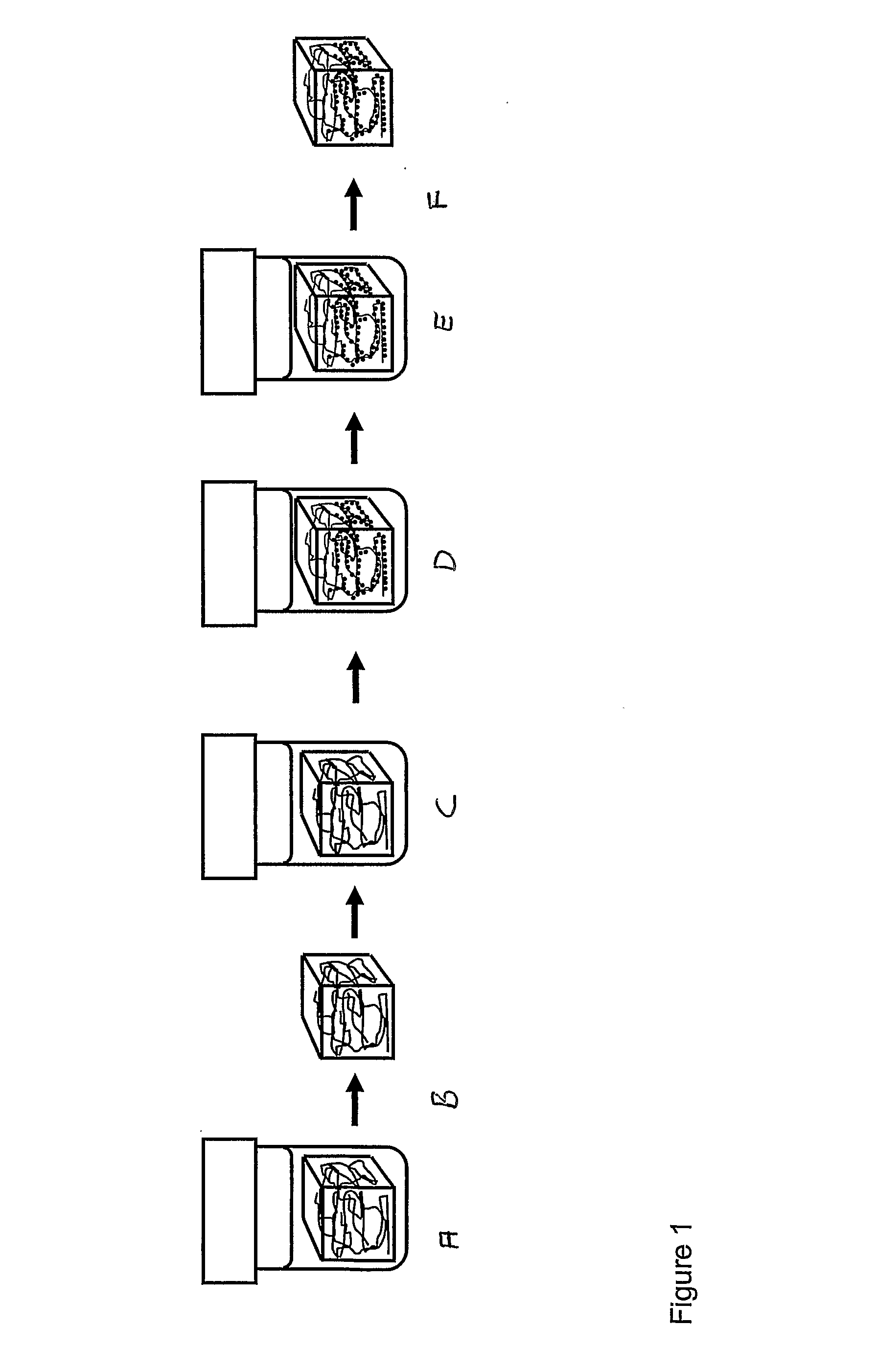Magnetic nanoparticle cellulose material
a technology of cellulose and nanoparticles, applied in the field of magnetic nanoparticle cellulose materials, can solve the problems of uneven distribution of nanoparticle systems, severe agglomeration and aggregates of nanoparticles, and poor representation of micron-sized filler materials in polymers, and achieve high mechanical performance nanoparticles, low apparent density, and reproducibility. high
- Summary
- Abstract
- Description
- Claims
- Application Information
AI Technical Summary
Benefits of technology
Problems solved by technology
Method used
Image
Examples
example 1
CoFe2O4
[0081]Precipitation of cobalt ferrite to form nanocrystals on the nanofibres of the bacterial cellulose.[0082]1. A piece of gel-like bacterial cellulose (0.5×0.5×1.5 cm) is boiled with 10 vol % NaOH solution (3 h) and sub sequentially washed with running distilled water (6 h) before immersion in liquid nitrogen followed by freeze-drying during a period of 12 hours.[0083]2. The dry cellulose piece is swollen in freshly prepared MilliQ-water solution of metal salt consisting of CoCl2×6H2O (0.033 M) and FeSO4×7H2O (0.66 M), i.e. stoichiometric proportions of Co:Fe (1:2).[0084]3. The solutions with the immersed pieces of cellulose is heated to 90° C. and kept at 90° C. for 3 h in order to thermally force the precipitation of the iron / cobalt salt solution to the related hydroxide / oxide structures of the cobalt / iron ions inside the matrix network of the bacterial cellulose.[0085]4. The piece is transferred into a 90° C. solution of NaOH (1.32 M) with KNO3 (0.15 M) ; ([Fe2+]* / [NO3−...
example 2
CoFe2O4
[0090]1. A piece of gel-like bacterial cellulose (0.5×0.5×1.5 cm) is boiled with 10 vol % NaOH solution (3 h) and sub sequentially washed with running distilled water (6 h) before immersion in liquid nitrogen followed by freeze-drying during a period of 12 hours.[0091]2. The dry cellulose piece is swollen in freshly prepared MilliQ-water solution of metal salt consisting of CoCl2×6H2O (0.055 M) and FeSO4×7H2O (0.11 M), i.e. stoichiometric proportions of Co:Fe (1:2).[0092]3. The solutions with the immersed pieces of cellulose is heated to 90° C. and kept at 90° C. for 3 h in order to thermally force the precipitation of the iron / cobalt salt solution to the related hydroxide / oxide structures of the cobalt / iron ions inside the matrix network of the bacterial cellulose.[0093]4. The piece is transferred into a 90° C. solution of NaOH (1.32 M) with KNO3 (0.25 M); ([Fe2+]* / [NO3−]=0.44). The piece is kept in this alkaline solution, which is maintained at 90° C. for 6 h.[0094]5. The...
example 3
CoFe2O4
[0098]1. A piece of gel-like bacterial cellulose (0.5×0.5×1.5 cm) is boiled with 10 vol % NaOH solution (3 h) and sub sequentially washed with running distilled water (6 h) before immersion in liquid nitrogen followed by freeze-drying during a period of 12 hours.[0099]2. The dry cellulose piece is swollen in freshly prepared MilliQ-water solution of metal salt (saturated) prepared by dissolving CoCl2×6H2O (0.33 M) and FeSO4×7H2O (0.66 M), i.e. stoichiometric proportions of Co:Fe (1:2).[0100]3. The solutions with the immersed pieces of cellulose is heated to 90° C. and kept at 90° C. for 3 h in order to thermally force the precipitation of the iron / cobalt salt solution to the related hydroxide / oxide structures of the cobalt / iron ions inside the matrix network of the bacterial cellulose.[0101]4. The piece is transferred into a 90° C. solution of NaOH (1.32 M) with KNO3 (1.5 M); ([Fe2+]* / [NO3−]=0.44). The piece is kept in the alkaline solution at 90° C. for 6 h.[0102]5. The pie...
PUM
| Property | Measurement | Unit |
|---|---|---|
| to particle inter-distance | aaaaa | aaaaa |
| diameter | aaaaa | aaaaa |
| size | aaaaa | aaaaa |
Abstract
Description
Claims
Application Information
 Login to View More
Login to View More - R&D
- Intellectual Property
- Life Sciences
- Materials
- Tech Scout
- Unparalleled Data Quality
- Higher Quality Content
- 60% Fewer Hallucinations
Browse by: Latest US Patents, China's latest patents, Technical Efficacy Thesaurus, Application Domain, Technology Topic, Popular Technical Reports.
© 2025 PatSnap. All rights reserved.Legal|Privacy policy|Modern Slavery Act Transparency Statement|Sitemap|About US| Contact US: help@patsnap.com



